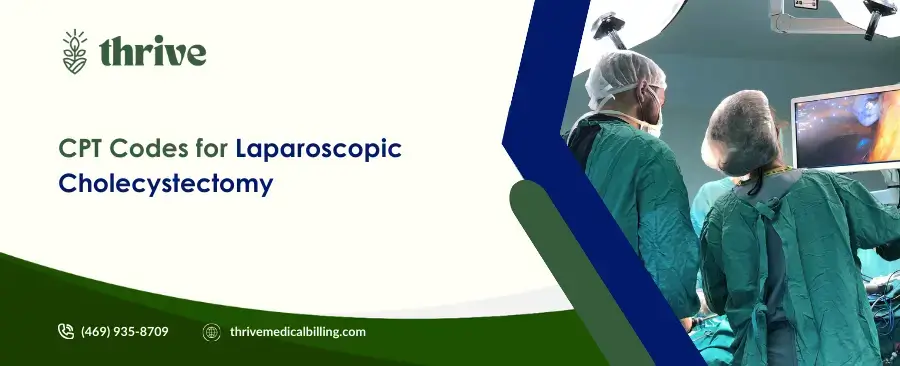Introduction to CPT Code for Laparoscopic Cholecystectomy
CPT code for laparoscopic cholecystectomy refers to the procedural codes used in medical billing to describe the surgical removal of the gallbladder using a minimally invasive laparoscopic technique. These codes are part of the Current Procedural Terminology (CPT) system maintained by the American Medical Association (AMA) and are commonly used by general surgeons and billing professionals in surgical procedures. Understanding the CPT code for laparoscopic cholecystectomy is essential for healthcare providers to ensure accurate billing and avoid issues that lead to claim denials.
This guide provides a detailed overview of the CPT codes for laparoscopic cholecystectomy, their applications, modifiers, Medicare reimbursement rates, and strategies to optimize billing for gallbladder surgery addressing conditions like gallstones and cholecystitis.
What is Laparoscopic Cholecystectomy and Its CPT Codes?
Laparoscopic cholecystectomy is a minimally invasive surgery to remove the gallbladder, typically performed to treat gallstones, cholecystitis, or other gallbladder-related conditions. The procedure uses a laparoscope (a thin tube with a camera) and small incisions to access and remove the gallbladder, offering faster recovery compared to open surgery. The primary CPT codes for laparoscopic cholecystectomy are:
- CPT Code 47562: Laparoscopic cholecystectomy without cholangiography (imaging of the bile ducts).
- CPT Code 47563: Laparoscopic cholecystectomy with cholangiography, involving imaging to assess the bile ducts for obstructions or abnormalities.
- CPT Code 47564: Laparoscopic cholecystectomy with exploration of the common bile duct, used when additional procedures are performed to address bile duct issues.
These codes are used in surgical procedures performed in hospitals or ambulatory surgery centers by general surgeons or other qualified specialists. The choice of code depends on whether cholangiography or bile duct exploration is performed during the surgery.
Procedure Involving Laparoscopic Cholecystectomy
The procedure involving laparoscopic cholecystectomy (CPT codes 47562, 47563, 47564) includes the following steps:
- Patient Preparation: The patient is placed under general anesthesia, and the abdomen is prepped. The surgeon reviews the patient’s medical history and indications (e.g., gallstones, cholecystitis).
- Incision and Laparoscope Insertion: Small incisions (typically 3–4) are made in the abdomen, and a laparoscope is inserted to visualize the gallbladder and surrounding structures.
- Gallbladder Dissection: The surgeon uses laparoscopic instruments to dissect the gallbladder from the liver bed, clipping and dividing the cystic duct and artery.
- Cholangiography (if applicable, CPT 47563): A contrast dye is injected to image the bile ducts, ensuring no stones or obstructions are present.
- Common Bile Duct Exploration (if applicable, CPT 47564): If bile duct issues are suspected, the surgeon explores and potentially removes stones or addresses obstructions.
- Gallbladder Removal: The gallbladder is removed through one of the small incisions, typically in a retrieval bag.
- Closure and Recovery: Incisions are closed, and the patient is monitored in the recovery room before discharge or admission, depending on the setting.
The procedure typically lasts 1–2 hours, depending on complexity and additional interventions. CPT codes 47562–47564 cover the professional and technical components of the surgery.
Comparison with Related CPT Codes
CPT codes 47562, 47563, and 47564 are part of the cholecystectomy code set, which varies based on the surgical approach and additional procedures. Here’s how they compare to related codes:
- CPT Code 47600: Open cholecystectomy without cholangiography, used for traditional open surgery, unlike the laparoscopic approach of 47562.
- CPT Code 47605: Open cholecystectomy with cholangiography, distinct from 47563.
- CPT Code 47570: Laparoscopic cholecystoenterostomy (gallbladder-intestine anastomosis), a different procedure from standard cholecystectomy.
- CPT Code 43280: Laparoscopic cholecystectomy with intraoperative cholangiography and additional pancreatic or biliary procedures, more complex than 47563.
- CPT Code 47579: Unlisted laparoscopic procedure for the liver or biliary system, used when no specific code applies.
Choosing the correct procedural code is critical to ensure accurate billing. For example, billing CPT code 47562 for a procedure with cholangiography (47563) or using an open surgery code (47600) for a laparoscopic procedure can lead to claim denials.
Modifiers for Laparoscopic Cholecystectomy CPT Codes
Modifiers provide additional context for CPT codes 47562, 47563, and 47564 to ensure proper reimbursement. The following modifiers are sourced from the AMA’s CPT Professional Edition and CMS’s National Correct Coding Initiative (NCCI) Policy Manual:
- Modifier 22 (Increased Procedural Services): Used when the procedure is significantly more complex or time-consuming than usual (e.g., extensive adhesions), requiring additional documentation, per AMA guidelines.
- Modifier 51 (Multiple Procedures): Indicates multiple procedures performed during the same session, though payers may apply payment adjustments, per AMA standards.
- Modifier 53 (Discontinued Procedure): Applied when the procedure is stopped for safety reasons (e.g., intraoperative complications), as outlined in AMA guidelines.
- Modifier 59 (Distinct Procedural Service): Denotes a separate procedure on the same day, such as a cholecystectomy with a distinct procedure like a biopsy. Use cautiously to avoid unbundling issues, per CMS’s NCCI edits.
- Modifier 80 (Assistant Surgeon): Used when an assistant surgeon is required, per AMA and CMS guidelines.
- Modifier 99 (Multiple Modifiers): Applied when multiple modifiers are needed, per AMA standards.
Providers must follow AMA and payer guidelines, including Medicare’s NCCI edits, to avoid errors that lead to claim denials. For example, Modifier 26 (professional component) is not typically used with these surgical codes, as they are global procedures.
Medicare Reimbursement Rates for Laparoscopic Cholecystectomy
CPT codes 47562, 47563, and 47564 are reimbursable by Medicare, but reimbursement rates vary based on several factors:
- Medicare Physician Fee Schedule (MPFS): The MPFS provides payment rates for CPT codes 47562–47564, adjusted by the Geographic Practice Cost Index (GPCI) for regional cost differences, as outlined by CMS.
- Medicare Administrative Contractors (MACs): Regional MACs may impose specific billing rules or coverage criteria, such as Local Coverage Determinations (LCDs) for surgical procedures.
- Facility vs. Non-Facility Rates: Facility rates (e.g., hospitals) reflect professional services, as facility costs are covered separately (e.g., via DRG payments), while non-facility rates (e.g., ambulatory surgery centers) include technical components, per the CMS MPFS.
- Bundling Considerations: Medicare may bundle related services (e.g., intraoperative imaging or anesthesia) unless distinct procedures are documented, per CMS’s NCCI Policy Manual.
To verify reimbursement rates for 2025, providers should:
- Check the MPFS on the Centers for Medicare & Medicaid Services (CMS) website.
- Consult their regional MAC for specific coverage policies and billing rules.
- Use coding tools like AAPC Coder or Kareo for rate estimates.
Accurate documentation of medical necessity, such as gallstones, cholecystitis, or biliary colic, is critical for Medicare reimbursement, per CMS’s Medicare Claims Processing Manual.
Conditions Treated with Laparoscopic Cholecystectomy
CPT codes 47562, 47563, and 47564 are used to treat various gallbladder-related conditions through laparoscopic cholecystectomy, including:
- Gallstones (Cholelithiasis): To remove gallstones causing pain, obstruction, or inflammation.
- Acute Cholecystitis: To treat inflammation of the gallbladder, often due to gallstone obstruction.
- Chronic Cholecystitis: To address recurrent or chronic gallbladder inflammation.
- Biliary Colic: To relieve severe abdominal pain caused by gallstone movement.
- Gallbladder Polyps or Masses: To remove abnormal growths that may be precancerous or symptomatic.
- Bile Duct Obstruction (with CPT 47564): To address stones or strictures in the common bile duct.
The minimally invasive nature of laparoscopic cholecystectomy makes it the preferred approach for most gallbladder conditions, reducing recovery time and complications.
Medical Billing Best Practices to Ensure Accurate Billing
To ensure accurate billing for CPT codes 47562, 47563, and 47564 and minimize issues that lead to claim denials, providers should adopt the following medical billing strategies:
- Train Staff: Educate billing staff on the CPT codes for laparoscopic cholecystectomy, their differences (e.g., 47562 vs. 47563), and appropriate modifiers, using resources like the AMA’s CPT Professional Edition.
- Use EHR Systems: Electronic health records like Epic or Cerner streamline documentation and coding for surgical procedures.
- Document Medical Necessity: Clearly note the indications (e.g., gallstones, cholecystitis), procedure details, and any additional interventions (e.g., cholangiography, bile duct exploration) to justify the chosen code.
- Verify Payer Guidelines: Confirm Medicare and private payer rules for CPT codes 47562–47564, especially regarding bundling, modifier use, and coverage for intraoperative imaging.
- Conduct Regular Audits: Review claims to ensure compliance with AMA and CMS guidelines, using tools like AAPC Coder or internal audit processes.
These practices optimize revenue cycle management and improve financial outcomes for surgical practices.
Common Errors That Lead to Claim Denials
Billing errors for CPT codes 47562, 47563, and 47564 can lead to claim denials, delaying reimbursement. Common mistakes include:
- Incorrect Code Selection: Billing CPT code 47562 for a procedure with cholangiography (47563) or using an open surgery code (47600) for a laparoscopic procedure.
- Improper Modifier Use: Applying Modifier 59 without clear documentation of a distinct service or using Modifier 22 without sufficient justification, per CMS’s NCCI Policy Manual.
- Inadequate Documentation: Failing to document medical necessity, intraoperative findings, or additional procedures like cholangiography to support the chosen code.
- Unbundling Errors: Billing CPT codes 47562–47564 with other surgical or imaging codes without justification, violating NCCI edits.
- Non-Compliance with Payer Policies: Not adhering to Medicare or private payer rules for procedure indications or frequency.
Providers should verify codes, modifiers, and documentation to ensure accurate billing and avoid denials, aligning with AMA and CMS standards.
Conclusion and Resources
CPT codes 47562, 47563, and 47564 are critical procedural codes for laparoscopic cholecystectomy, enabling effective gallbladder surgery for conditions like gallstones, cholecystitis, and biliary colic in minimally invasive surgery. By understanding the CPT code for laparoscopic cholecystectomy, its modifiers, Medicare reimbursement rates, and best practices for medical billing, providers can ensure accurate billing and minimize issues that lead to claim denials. For further guidance, consult:
- CMS Website: For MPFS, NCCI edits, and reimbursement rates.
- American Medical Association (AMA): For CPT code updates and guidelines.
- American College of Surgeons (ACS): For resources on surgical procedures and gallbladder surgery.
By staying informed and proactive, healthcare providers can optimize billing for laparoscopic cholecystectomy and enhance patient care through effective surgical interventions.








